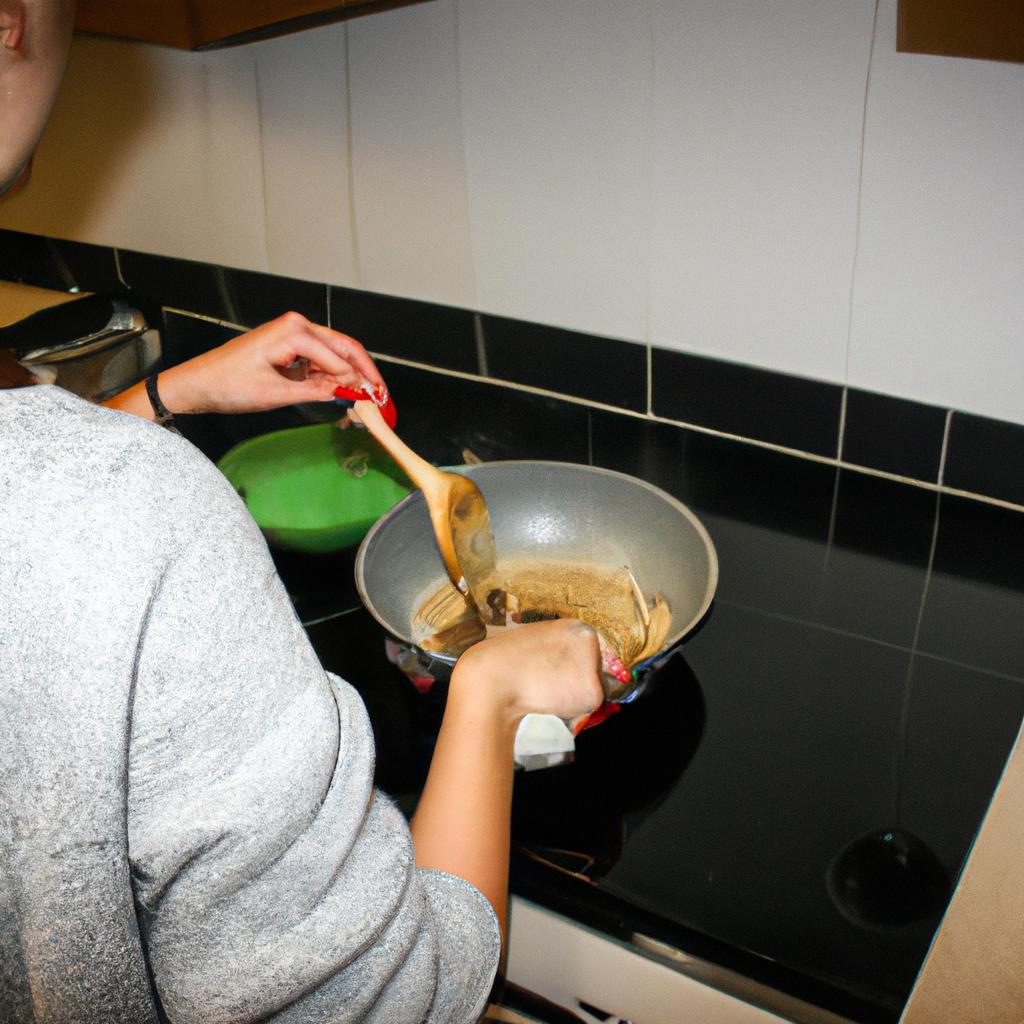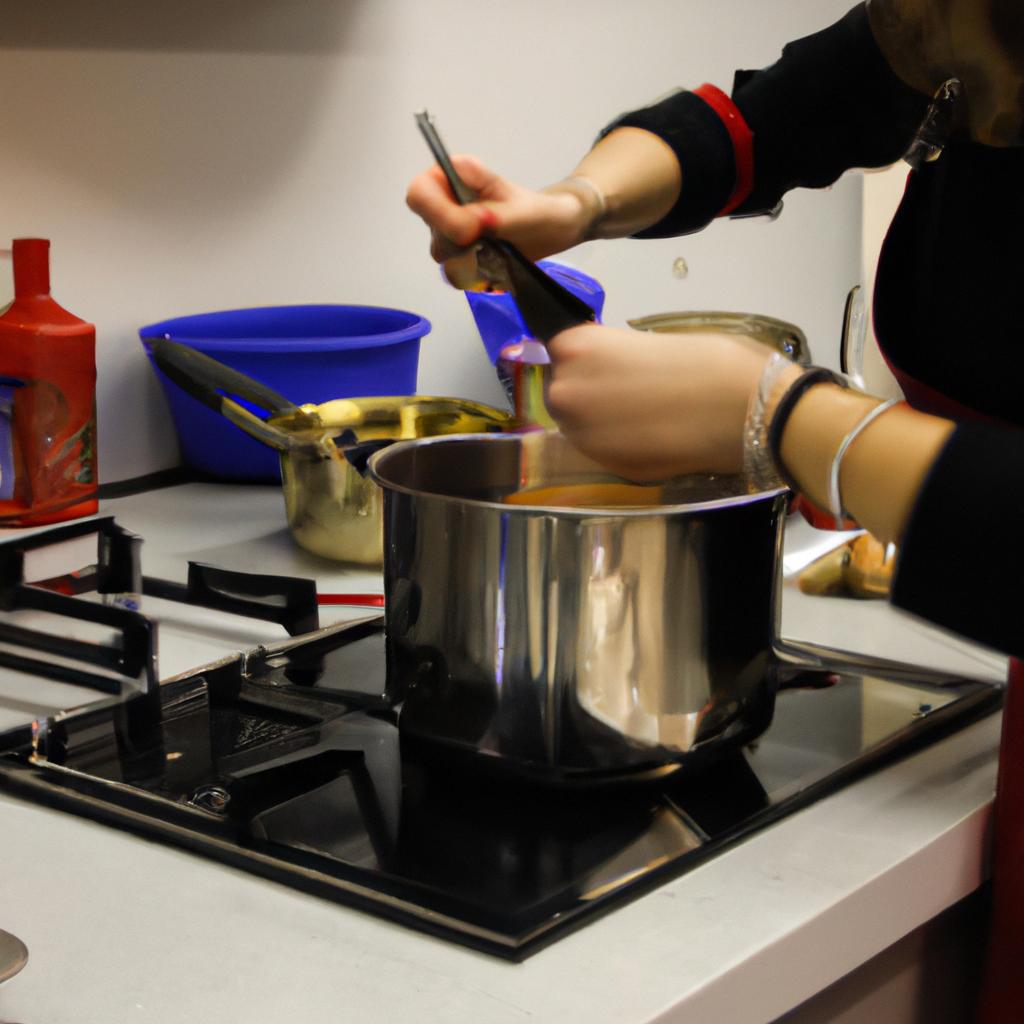Culinary history is a fascinating field of study that explores the intersection between food and culture throughout the ages. By examining the past, we can gain valuable insights into how different societies have nourished themselves, celebrated special occasions, and expressed their unique identities through cuisine. This article delves into the realm of culinary history with an emphasis on its recreation in contemporary times. Through exploring various case studies and hypothetical scenarios, we will delve into the ways in which individuals and communities seek to revive and recreate historical recipes and dining experiences.
One compelling example of this phenomenon can be found in the revival of ancient Egyptian cuisine. In recent years, there has been a growing interest among historians, archaeologists, and food enthusiasts alike in resurrecting long-lost recipes from this ancient civilization. Imagine tasting dishes similar to those enjoyed by pharaohs thousands of years ago – experiencing flavors that were once savored by the ruling elite or partaken during religious ceremonies. Such endeavors not only satisfy our curiosity about the past but also provide us with a deeper understanding of ancient cultures and their relationship with food.
By studying culinary history and engaging in recreating historical meals, individuals are able to connect with their heritage on a more profound level. Moreover, these endeavors offer us an opportunity to appreciate the ingenuity and creativity of our ancestors in their culinary practices. It allows us to recognize the skill and knowledge that went into creating these dishes without the modern conveniences we often take for granted. Through recreating historical meals, we can gain a greater appreciation for the cultural significance of certain ingredients, cooking techniques, and even the social dynamics surrounding mealtime.
Additionally, engaging in culinary history helps us understand how food has shaped societies and influenced cultural exchange throughout time. Exploring recipes from different eras and regions allows us to trace the migration of ingredients, spices, and cooking methods across borders. By doing so, we can discover shared culinary traditions between distant cultures or uncover forgotten connections between seemingly unrelated cuisines.
Furthermore, by reviving historical recipes and dining experiences, we have an opportunity to preserve traditional culinary knowledge that might otherwise be lost to time. Many ancient recipes were passed down orally through generations but eventually faded away as societies underwent changes. Recreating these dishes not only brings them back to life but also ensures their continued existence for future generations.
In conclusion, delving into culinary history by recreating historical meals allows us to connect with our past on a personal level while gaining insights into broader cultural contexts. By appreciating the flavors and techniques of ancient cuisines, we can deepen our understanding of human history and celebrate the diversity of food culture worldwide.
Ancient Culinary Practices
Imagine stepping back in time to ancient civilizations where culinary practices were vastly different from what we know today. One such example is the elaborate feasts of Ancient Rome, where wealthy citizens would indulge in extravagant meals featuring an array of exotic dishes and delicacies. These culinary traditions provide insight into how food was not only a means of sustenance but also a symbol of social status and cultural expression.
The culinary practices of ancient civilizations varied greatly across regions and cultures. In Egypt, for instance, bread played a central role in their diet, with various types made from wheat or barley. The Egyptians mastered the art of fermentation, using yeast to produce leavened bread that was lighter and more palatable than its unleavened counterpart. Moreover, they had a deep reverence for certain ingredients like garlic and onions, which were believed to have medicinal properties.
Although each civilization had its own unique culinary traditions, there are several commonalities that can be observed across ancient cultures:
- Emphasis on seasonal produce: Ancient societies relied heavily on locally available fruits, vegetables, and grains as staples in their diet.
- Preservation techniques: To overcome challenges posed by limited resources or harsh climates, ancient peoples developed methods such as drying, smoking, pickling, and fermenting to preserve food for extended periods.
- Rituals and symbolism: Food held great significance in religious ceremonies and rituals. It served as offerings to gods or ancestors and acted as a medium to establish connections between humans and the divine.
- Social gatherings: Sharing meals was an essential part of communal life in ancient times. Feasts brought people together for celebrations or important events while strengthening bonds within communities.
| Seasonal Produce | Preservation Techniques | Rituals and Symbolism | Social Gatherings |
|---|---|---|---|
| Fresh fruits | Drying | Offerings to deities | Festive banquets |
| Vegetables | Smoking | Ancestral connections | Communal feasts |
| Grains | Pickling | Spiritual significance | Celebratory events |
These ancient culinary practices laid the foundation for the evolution of cooking techniques and contributed to our modern understanding of food. As we delve further into history, it becomes evident that culinary traditions have continually evolved, influenced by factors such as migration, trade routes, and technological advancements. In the subsequent section on “Evolution of Cooking Techniques,” we will explore how these practices transformed over time to shape our contemporary culinary landscape.
Note: The table above is best viewed in a Markdown-compatible environment where it can be properly formatted with visible borders and aligned columns.
Evolution of Cooking Techniques
From the ancient culinary practices of civilizations such as the Egyptians, Greeks, and Romans, we now transition into exploring the evolution of cooking techniques. To illustrate this progression, let us consider a hypothetical scenario where an aspiring chef in ancient Rome discovers a new method for preserving food.
In ancient Rome, preservation methods were crucial to ensure that food supplies remained intact during long periods of travel or scarcity. Our imaginative young chef experiments with combining salt and smoke to preserve meat. This innovative technique not only extends the shelf life of meats but also enhances their flavors. Through trial and error, our chef perfects this process and shares it with other cooks across the empire.
The evolution of cooking techniques throughout history can be observed through several key developments:
- Advancements in heat sources: From open fires to wood-burning ovens and eventually gas stoves, different heat sources have influenced cooking styles and enabled more precise temperature control.
- Introduction of utensils and cookware: The invention of various tools like pots, pans, knives, and ladles has revolutionized how ingredients are prepared and cooked.
- Expansion of ingredient variety: Explorations by traders and travelers brought new spices, herbs, fruits, vegetables, and meats from distant lands into local cuisines.
- Technological innovations: Inventions such as pressure cookers, blenders, mixers, and electric ovens have streamlined cooking processes while saving time.
To further understand these advancements visually:
| Ancient Culinary Techniques | Evolutionary Cooking Techniques | Modern Culinary Innovations |
|---|---|---|
| Smoking | Roasting | Sous Vide |
| Fermentation | Baking | Molecular Gastronomy |
| Salting | Boiling | Induction Cooktops |
| Drying | Grilling | 3D Food Printing |
As we delve into historical culinary influences in the subsequent section about “Historical Culinary Influences,” we can appreciate the impact of these evolving techniques on contemporary cooking practices. The creativity and ingenuity of chefs throughout time have shaped our culinary traditions, laying the foundation for present-day gastronomy.
Historical Culinary Influences
From the early stages of human civilization, cooking techniques have evolved significantly, reflecting changes in societal norms and technological advancements. Understanding the evolution of these techniques provides valuable insights into how culinary practices have shaped our past. By examining specific case studies, such as the transition from open fire to stovetop cooking, we can gain a deeper appreciation for the historical significance of culinary innovation.
One notable example of this evolution is the shift from open fire cooking to stovetop methods. In ancient times, humans relied on fire pits as their primary means of preparing meals. However, with the advent of pottery and metalworking technologies, new possibilities emerged. The invention of clay ovens allowed for more controlled heat distribution and enhanced cooking efficiency. As societies progressed, stoves fueled by wood or coal became prevalent, offering further convenience and precision in temperature regulation.
This transformation not only revolutionized everyday cooking but also had profound implications for cultural practices surrounding food preparation. With the introduction of enclosed cookstoves came an increased emphasis on cleanliness and hygiene in kitchens. Additionally, stovetops brought about greater diversity in recipes that could be prepared simultaneously using multiple burners or oven compartments.
To illustrate the impact of evolving cooking techniques throughout history, consider the following bullet points:
- Improved heating capabilities led to the development of intricate baking techniques.
- Stovetops enabled chefs to experiment with delicate sauces and precise simmering.
- Enhanced control over temperature contributed to the rise of confectionery arts.
- The availability of diverse fuel sources fostered regional variations in cuisine.
Furthermore, a visual representation through a table can evoke emotions and enhance understanding:
| Cooking Technique | Advantages | Disadvantages |
|---|---|---|
| Open Fire | Primitive yet communal experience | Limited heat control |
| Clay Oven | Even heat distribution | Longer preheating time |
| Enclosed Stove | Precise temperature regulation | Dependence on fuel availability |
| Modern Appliances | Quick cooking times | Potential for overreliance |
In exploring the evolution of cooking techniques, it is evident that culinary practices have continually adapted to suit changing needs and preferences. The transformation from open fire pits to enclosed stovetops not only revolutionized meal preparation but also influenced cultural norms surrounding food. This historical context sets the stage for further exploration into the influential recipes that have stood the test of time.
Transitioning seamlessly into the subsequent section about “Famous Historical Recipes,” we delve deeper into the rich tapestry of culinary history by examining iconic dishes that have left an indelible mark on our collective gastronomic heritage.
Famous Historical Recipes
Having explored the various historical culinary influences, it is evident that our understanding of food has been shaped by a multitude of factors. From ancient civilizations to modern times, the recreation of past culinary practices continues to captivate us. In this section, we will delve into some famous historical recipes that offer an intriguing glimpse into the kitchens of yesteryears.
To truly appreciate the significance of historical recipes, let us consider the case study of “Coq au Vin,” a French dish dating back several centuries. This classic recipe combines chicken, red wine, mushrooms, onions, and bacon to create a rich and hearty stew-like preparation. By examining such celebrated dishes, we gain insights not only into their cultural origins but also how they have evolved over time.
When exploring famous historical recipes, it becomes apparent that these culinary creations serve as more than just sustenance; they provide a deep connection to our heritage. Here are four key reasons why historical recipes continue to evoke an emotional response in people worldwide:
- Nostalgia: These recipes act as portals to different eras and can transport us back in time.
- Cultural Identity: They reflect traditional cooking methods unique to specific regions or communities.
- Sense of Continuity: Preparing these age-old dishes helps maintain connections with our ancestors.
- Appreciation for Tradition: Historical recipes showcase the skills and craftsmanship passed down through generations.
In addition to their emotional impact, historical recipes often embody fascinating stories associated with their origin or preparation techniques. Consider the following table showcasing three iconic historical dishes along with their captivating narratives:
| Dish | Origin | Narrative |
|---|---|---|
| Peking Duck | China | Originally reserved for emperors, this dish’s preparation involves intricate techniques. |
| Bouillabaisse | France | This Provençal seafood stew was initially made by Marseille fishermen using unsold catch. |
| Black Forest Cake | Germany | Inspired by the Black Forest region, this cake features layers of chocolate and cherries. |
Food enthusiasts worldwide find themselves drawn to historical recipes due to their ability to transport us through time and evoke a sense of cultural heritage. As we move forward in our culinary exploration, let us now turn our attention to the fascinating realm of food in ancient civilizations.
Transition into Subsequent Section:
With historical recipes serving as a bridge between the past and present, it is intriguing to delve deeper into the role of food in ancient civilizations. By examining the diets, cooking methods, and societal significance of these early cultures’ cuisine, we can gain a profound understanding of how food shaped human civilization.
Food in Ancient Civilizations
Culinary History: The Past in Recreation and Food
Famous Historical Recipes have long captured the imagination of culinary enthusiasts, providing a glimpse into the tastes and techniques of bygone eras. As we delve deeper into the annals of gastronomy, it becomes evident that food not only sustains us physically but also serves as a window to explore ancient civilizations. In this section, we will examine how food played an integral role in shaping these societies and discover the fascinating ingredients, preparations, and cultural significance associated with them.
Consider Ancient Egypt, where bread held immense importance in both religious rituals and everyday life. One can imagine a bustling marketplace filled with vendors selling various types of bread made from wheat or barley flour. This staple food sustained not just Pharaohs but also peasants alike, showcasing its widespread consumption across social classes.
Exploring different civilizations through their cuisine allows us to uncover remarkable insights about their way of life:
-
Mesopotamia:
- Rich agricultural practices supported diverse crops like wheat, barley, dates, and figs.
- Fermentation techniques led to the creation of beer—a popular beverage enjoyed during festive occasions.
- Animal husbandry introduced lamb as a prominent protein source for Mesopotamians.
-
Ancient China:
| Ingredient | Preparation Method | Cultural Significance |
|---|---|---|
| Dumplings | Steamed or pan-fried dumplings were commonly consumed during Lunar New Year celebrations. | Symbolized wealth and good fortune for the upcoming year. |
| Rice | Boiled rice served as a staple accompaniment to many meals. | Represented fertility and abundance within Chinese culture. |
| Soy Sauce | A fermented condiment made from soybeans—essential for adding flavor to dishes. | Used to enhance umami taste and balance flavors in Chinese cuisine. |
- Aztecs:
- Maize (corn) formed the foundation of the Aztec diet, used in various forms like tortillas and tamales.
- Chocolate was revered as a luxury item reserved for nobility and played a crucial role in religious ceremonies.
- Tomatoes, chili peppers, and beans were integral ingredients that still find their way into Mexican cuisine today.
By exploring these culinary traditions, we gain not only an understanding of the past but also a deeper appreciation for our own contemporary food culture. The revival of traditional cuisines allows us to connect with our heritage while embracing modern innovation. In the subsequent section on the “Revival of Traditional Cuisines,” we will explore how chefs and home cooks alike are breathing new life into ancient recipes by combining old techniques with novel approaches.
Revival of Traditional Cuisines
From the flourishing food culture of ancient civilizations to the modern era, culinary traditions have evolved significantly. Building upon our exploration of food in ancient civilizations, we now delve into the revival of traditional cuisines. This section examines how communities and individuals are embracing their cultural heritage by recreating historical recipes and reviving forgotten cooking techniques.
One compelling example that showcases this revival is the resurgence of medieval cuisine in Europe. Medieval banquets, once a thing of the past, are now being meticulously recreated by historians, chefs, and enthusiasts alike. These immersive experiences allow participants to taste dishes from centuries ago while gaining insights into the social dynamics and gastronomic practices prevalent during that period.
The revival of traditional cuisines reflects a broader trend towards reconnection with cultural roots and rediscovery of lost flavors. Here are some key factors driving this movement:
- Cultural Identity: Traditional cuisines play a vital role in shaping cultural identity, providing individuals with a sense of belonging and pride in their heritage.
- Nostalgia: Rediscovering ancestral recipes can evoke feelings of nostalgia, transporting individuals back to simpler times when family gatherings centered around home-cooked meals.
- Sustainability: Embracing traditional diets often aligns with sustainable practices as these diets tend to rely on locally sourced ingredients and seasonal produce.
- Culinary Tourism: The growing interest in food tourism has fueled efforts to revive traditional cuisines as they offer unique culinary experiences for travelers seeking authenticity.
To further illustrate the impact of this revival movement, consider the following table showcasing three revived traditional cuisines from different regions:
| Region | Revived Cuisine | Notable Dishes |
|---|---|---|
| Mexico | Pre-Hispanic Cuisine | Tamales de Huitlacoche |
| India | Ayurvedic Cuisine | Turmeric-infused Basmati Rice |
| Japan | Washoku | Miso Soup with Seasonal Vegetables |
As we witness the resurgence of traditional cuisines, it becomes evident that food acts as a powerful link between past and present. By embracing historical recipes and cooking techniques, communities are not only preserving their culinary heritage but also fostering a deeper appreciation for cultural diversity. This revival movement highlights the enduring significance of food in shaping our collective memory and reminds us that the past can indeed be recreated on our plates.
 Refoksa
Refoksa



